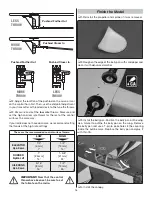
30
speed, decrease up elevator allowing the tail to come off the
ground. One of the most important things to remember with
a tail dragger is to always be ready to apply
right
rudder to
counteract engine torque. Gain as much speed as your runway
and fl ying site will practically allow before gently applying up
elevator, lifting the model into the air. At this moment it is likely
that you will need to apply more right rudder to counteract
engine torque. Be smooth on the elevator stick, allowing the
model to establish a
gentle
climb to a safe altitude before
turning into the traffi c pattern. Retract the landing gear.
Flight
It is a good idea to have an assistant on the fl ight line with
you to keep an eye on other traffi c. Take it easy with the
Ultra Sport .46/EP for the fi rst few fl ights, gradually getting
acquainted with it as you gain confi dence. Adjust the trims
to maintain straight and level fl ight. After fl ying around for a
while, and while still at a safe altitude with plenty of fuel or
battery capacity, practice slow fl ight and execute practice
landing approaches by reducing the throttle to see how the
model handles at slower speeds. Add power to see how she
climbs as well. Continue to fl y around, executing various
maneuvers and making mental notes of what trim or C.G.
changes may be required to fi ne tune the model so it fl ies
the way you like. Mind your fuel or battery level, but use this
fi rst fl ight to become familiar with your model before landing.
Landing
To initiate a landing approach, lower the landing gear and
lower the throttle while on the downwind leg. Continue to
lose altitude, but maintain airspeed by keeping the nose
down as you turn onto the crosswind leg. Make your fi nal
turn toward the runway (into the wind) keeping the nose
down to maintain airspeed and control. Level the attitude
when the model reaches the runway threshold, modulating
the throttle as necessary to maintain your glide path and
airspeed. If you are going to overshoot, smoothly advance
the throttle (always ready on the right rudder to counteract
torque). Climb out to make another attempt. When the model
is a foot or so off the deck, smoothly increase up elevator
until it gently touches down. Once the model is on the runway
and has lost fl ying speed, hold up elevator to place the tail
on the ground, regaining tail wheel control.
FINAL NOTE:
Have a goal or fl ight plan in mind each time you
fl y. This may be learning or improving a maneuver or learning
how the model behaves at certain speeds and control rates.
Every maneuver should be deliberate, not impulsive. A fl ight
plan reduces the chances of crashing your model because
of poor planning and impulsive moves.
Have a ball! But always stay in control
and fl y in a safe manner.
GOOD LUCK AND GREAT FLYING!
Tape to underside of canopy as a reference.
These are the recommended control surface throws:
ELEVATOR
HIGH
LOW
1/2"
[13 mm]
14°
1/4"
[ 6 mm]
7°
1/2"
[13 mm]
26°
5/16"
[ 8 mm]
16°
1-5/8"
[ 41mm]
24°
1"
[ 25 mm]
14°
RUDDER
AILERONS
Up & Down
Up & Down
Right & Left
Содержание ULTRA SPORT 46
Страница 31: ...Notes 31...



































